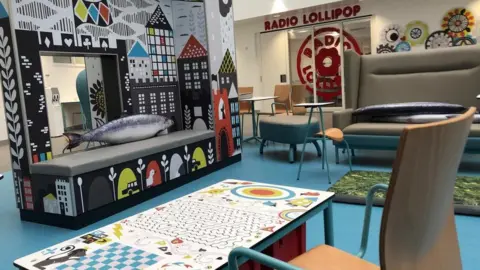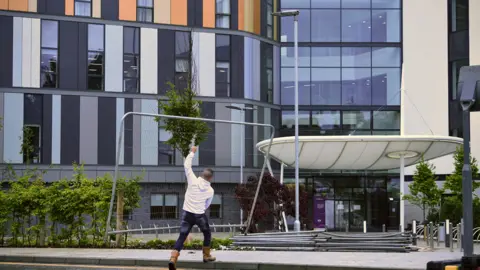Spreadsheet error led to Edinburgh hospital opening delay
 BBC
BBCA mistake in a spreadsheet set in motion a series of events that delayed the opening of a £150m hospital, a new report has revealed.
Last-minute issues with ventilation prevented the opening of Edinburgh's new children's hospital last July.
An NHS Lothian-commissioned review found a "human error" in a 2012 spreadsheet with the specifications for air flow in critical care rooms.
The mistake was missed in what auditors describe as a "collective failure".
It was only when the hospital had been handed over to NHS Lothian, and £1.4m monthly repayments had started, that independent checks found the critical care rooms were operating with the wrong air flow.
Remedial work worth £16m has since been carried out and the new Sick Kids building started hosting outpatient appointments in July.
But the hospital's full opening date, previously pencilled in for the autumn, is under review in light of the coronavirus crisis.
NHS Lothian said it had already made a number of the recommendations for improvement in the report to "ensure that future capital projects will benefit".
'Collective failure'
A public inquiry into the issues at the Sick Kids hospital and Queen Elizabeth University Hospital campus in Glasgow is also under way.
NHS Lothian asked audit firm Grant Thornton to conduct a review of the health board's role in the Sick Kids project, the first NHS hospital to be built using the Scottish government's private financing model known as Non-Profit Distribution (NPD).

NHS Lothian set the requirements for the hospital but private consortium IHSL designed, built, and financed the facility in a deal which over the next 25 years, including maintenance and facilities management fees, will cost £432m.
The Grant Thornton review concluded there was "collective failure from the parties involved" and that it was "not possible to identify one single event which resulted in the errors".
What went wrong?
The crux of the Sick Kids saga is that the hospital's critical care rooms need 10 air changes per hour to comply with ventilation guidelines designed to control infections.
Complying with these guidelines was in the project contract but the critical care rooms were completed with a ventilation system that only did four air changes per hour.
The Grant Thornton report spells out how this oversight was not spotted.
- A spreadsheet called the "environmental matrix" and dated from 2012 contained the "four air changes" error for critical care. The Grant Thornton report states: "This looks to be, based on our review, human error in copying across the four-bedded room generic ventilation criteria into the critical care room detail". None of the independent contractors involved in the matrix picked up on the oversight
- The environmental matrix was then included in the 2013 tendering process where three firms were bidding to build the hospital. One of the three bidders submitted a revised environmental matrix with the correct air changes for critical care but they did not win the contract and the correction was not picked up on by the team evaluating the bids
- In 2019 a contract row between NHS Lothian and IHSL was settled for £11.9m amidst concerns about the consortium's cash flow, according to the report. However, this "cemented the error contractually" because the "four air changes" error for critical care was written into this deal
- Another error in the environmental matrix, the inclusion of en-suite bathrooms in critical care, was spotted in 2016 but the air changes mistake was not identified at this stage
- An independent tester appointed by both sides "did not identify the non-compliance with the guidance within critical care", according to the report
Health board 'not consulted' on finance switch
The Grant Thornton report cites the complexity of the project as being a big factor in its repeated problems.
It notes the new hospital was switched from a traditionally financed project to the NPD model in 2010, adding "NHS Lothian were not consulted on the change in funding model in advance of the decision being taken".
This move came after four years of work by NHS Lothian on the project.
The health board handed over its work to potential bidders to try and speed up the procurement process but made clear the responsibility for the design and build would be with the winning consortium.
But the move, approved by the Scottish government, created "potential ambiguity" over design requirements, according to the report.
 Getty Images
Getty ImagesCalum Campbell, chief executive of NHS Lothian, praised the extent of analysis in the review given the "complex and significant" range of documentation associated with the 12-year-old project.
He said: "Recommendations in relation to decision making, clarity, clinical engagement and involvement of external advisers have been made.
"Some areas identified have already been addressed and others will be implemented within the agreed timeframes to ensure that future capital projects will benefit.
"The Department of Clinical Neurosciences and children's outpatient services have already settled into their new home and we are looking forward to the full opening as soon as possible."
'Past mistakes'
In a statement, the Scottish government said the safety and well-being of patients and their families was their top priority and should be the "primary consideration in all NHS construction projects".
"A public inquiry is under way to help us understand the issues that affected both the Queen Elizabeth University Hospital campus site in Glasgow and the Royal Hospital for Children and Young People and Department of Clinical Neurosciences site in Edinburgh.
"It will also make recommendations to ensure that any past mistakes are not repeated in future NHS infrastructure projects."
